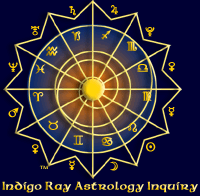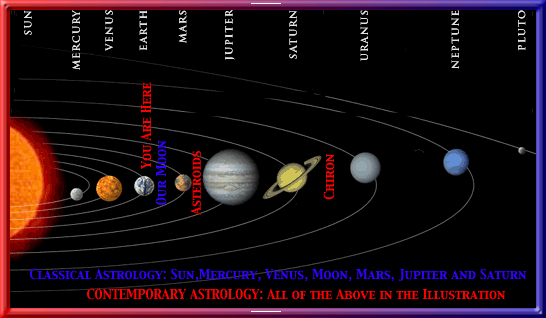| Note to the reader: suggested keywords for interpretations and characteristics through out the lessons are just that, suggested. They are by no means all inclusive or exhausted. The reader is encouraged to draw from their own experiences to develop their own adjectives to describe the signs, planets, houses and aspects. Introduction
|
| Since antiquity, gazing upward to the sky above has been a part of daily life. Predicting seasonal changes were measured by the longest and shortest days (the solstices), and by the times when night and day were the same length (equinoxes), this became a simple calendar for survival. Aside from these practical repetitive cycles, the position of the sun and/or moon were cited at the time of important events. This was a way of verifying if the event in the sky coincided with the event on planet. The similarities were often considered omens, and each tribe embellished them with their own myths and legends according to their worldview. Lore about the heavens above became abundant throughout the world. They spoke of gods, and heroes that formed a complex hierarchy of celestial beings who watched, judged, and manipulated the lives on the planet Earth. As civilizations evolved ancient astrologers kept copious calendars monitoring the celestial movements.The most convenient way to study the stars was by connecting their groupings into recognizable patterns we now call the constellations and fixed stars. This method gave birth to the classical astrology that is still practiced. The sky was divided into twelve segments. Each one represented by its own constellation. It was observed that the visible planets often appeared to cycle through they sky against this backdrop of constellations. These planets eventually acquired personalities and mythologies of their own, and astrologers soon began to affix significance to the position of these planets against certain constellations in the sky. Throughout the centuries, Astrology has dealt with the charting and interpretation of the cycles and movements of celestial objects. Through the use of computers, calculations that once took months for mathematicians to perform by hand can now be done in seconds, and the positions of planets can be computed to a hundredth of a degree. The interpretation part is another matter relying largely on practical research data from case studies and intuitive skills that come from years of experience. The interpretation of astrological events is a fine art. Astrology
deals with ten "planets".
Eight of these are the sister planets of the earth: Mercury, Venus,
Mars, Jupiter, Saturn, Uranus, Neptune, and Pluto. The other two
are the Sun and the Moon, neither of which is a planet but are
luminaries.
However, as seen from the earth, the Sun and Moon follow the same
path as the planets. Thus they are included in simply the listing
of planets. Planets represent different cosmic forces or energies that influence your basic character traits and your changing urges and needs as you experience this life's journey. They provide the energies that drive your physical, emotional, mental, and intuition systems. These planetary energies are modified by the planet's position in the zodiac, and by its relationships (aspects) to the other planets. Other celestial bodies that are considered by contemporary astrologers are the asteroids and Chiron. For the purpose of these introductory lessons we will be focusing on the "ten planets". We encourage the reader to pursue other texts about the study of asteroids and Chiron for information. Books we recommend are included in the Source Bibliography. This recommendation comes with the assumption that before seeking this information you have gained a firm foundation in the basic astrological practices. Planets fall into three groups according to how long it takes them to make one trip around the sun. The Personal Planets (also known as the Inner Planets), the Immediate Planets and the Transpersonal Planets (also known as the Outer Planets). ~The first group of planets takes less than two years to make a full cycle. These include the Sun, Moon, Mercury, Venus, and Mars. Since we experience the influence of these planetary cycles so often, we soon learn to recognize and control our reactions to them. These are the Personal Planets. * The keywords are suggested characteristics below but are not all inclusive as adjectives. Keywords, as you continue through the lessons, will become helpful in knitting together an effective interpretation to the charts you read. We do recommend that you work with memorizing keyword traits of the planets and their effect, zodiac signs, aspects and the houses. That study alone will allow you to manifest a fair and concise interpretation of all charts.
~The third group of planets moves so slowly that its energies influence entire generations in essentially the same, setting the culture tones for long periods of time. Uranus makes a full cycle in about 84 years, a full lifetime, while Neptune and Pluto take about two centuries (165 and 247 years respectively). The characteristics of these Transpersonal planets are as follows:
The influences of these transpersonal planets will vary among individuals, depending on how they relate to the other planets of the horoscope, and how they fall into a person's natal houses. The Sun's position in the zodiac is your familiar Sun sign. Often when a person asks "What's your Sign?", it is the Sun sign they are referring to. The Sun sign shows how you express your creative urges through conscious acts of will. The Sun is the Life Force of the Zodiac. The Sun rules the sign Leo. The Moon's position in the zodiac shows your unconscious emotional reactions to situations based on your early childhood experiences and family training. Often the Moon influences dreams of the subconscious. The Moon is the Other side of the Mirror for us. The Moon rules the sign Cancer. The planet Mercury's position in the zodiac describes your thought process and then how you communicate your ideas and decisions to others. It also reveals how you make decisions and what you consider before making a decision. Often its position can show modes of communication you prefer. Mercury is the EmCee of the Zodiac. The planet Mercury rules the sign Gemini. The planet Venus's position in the zodiac shows how you give of yourself and how you express your feelings for others. It also reveals how you attract the good things of life, both the material and the spiritual. Venus is the Artistic eye of the Zodiac. The planet Venus rules the sign Libra.
The planet Mars's position in the zodiac shows how you use your physical energies in expressing your needs. It affects your sex drive, ambitions, endurance, and aggressiveness. Mars, the God, is best known as the God of War and least known for the God of Husbandry. Mars does effect agriculture. Mars is the Provider of Sustenance of the Zodiac. The Planet Mars rules the sign Aries. The planet Jupiter's position in the zodiac shows how you express your need to grow. It shows your interests in the higher values of life and how you share those interests with others. When you think of the "Giant Planet" you think expansiveness. This is what energies of Jupiter challenge us to do in the physical, the intellect, the emotional but most important the spiritual—expand! Jupiter could be called the Philosopher of the Zodiac and the Comedian. The planet Jupiter rules the sign Sagittarius. The planet Saturn's position in the zodiac shows how you try to establish and protect your position in life. Saturn is the Wise Sage of the Zodiac. The Teacher asks its student to "know thyself". It also shows how you face responsibility and seek recognition for your efforts. Saturn is the Professor of the Zodiac. The planet Saturn rules the sign Capricorn. The planet Uranus's position in the zodiac shows something about the motivation, goals, and originality of those born in each seven year period during which Uranus is in each of the signs. After Saturn helps us find our limitations, Uranus assists in liberating us from those limitations. Uranus is the true non-conformist of the Zodiac because it rotates on its axis from top to bottom and not from side to side as we do. We refer to Uranus the Braveheart of the Zodiac. The planet Uranus rules the sign Aquarius. The planet Neptune's position in the zodiac influences the collective outlook of all those born within the same thirteen year period during which Neptune remains in one sign. Neptune show you the mystical and inspirational influences felt by each generation. But Neptune also challenges you to decide what is illusion and what is reality. Neptune often reveals deception and hidden mysteries of life. This Actor portrays is the Psychic of the Zodiac. The planet Neptune rules the sign Pisces. The planet Pluto's position in the zodiac influences the entire generation of people born within the same twelve to twenty-two year period during which Pluto remains in one sign. Pluto's energies show us the human need for regeneration and control in each generation. The farthest from us yet the most effecting of all the planets because it demands change and re-creation from us. There is no other name for Pluto but The Transformer of the Zodiac. The planet Pluto rules the sign Scorpio. Now that you have an idea on "the actors" and what they bring to the roles in this drama we call a life's journey, we will move on to the "roles" they play. On to Lesson 2: The Zodiac Signs: "The Roles" |
Introductory Lessons on Astrology || Lesson
2: The Signs ||
Frequently Asked Questions | Source
Bibliography | Glossary
| Birth
Charts |Transit
Charts |Career
Charts | Relationship
Charts | Horary
Charts | ©2001-2004, Indigo Ray Astrology Inquiry, All Rights Reserved |


